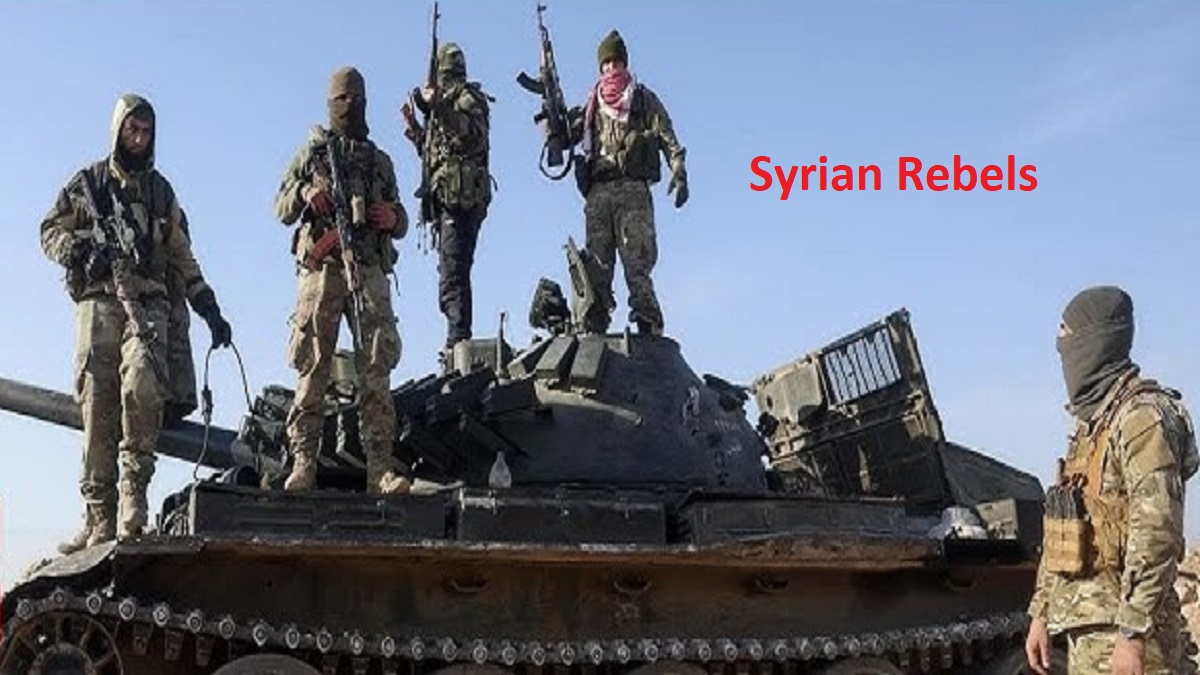The Syrian rebels refer to various groups that have opposed the government of Syrian President Bashar al-Assad during the Syrian Civil War, which began in 2011. Initially, the conflict started as part of the broader Arab Spring protests, where citizens demanded democratic reforms, but it soon escalated into a violent civil war.
Who are the Syrian Rebels
Syrian rebels can be broadly divided into the following categories:
- Secular Rebels: These are groups that aimed for political change, human rights, and democracy but without a religious agenda. Early in the war, these were the dominant forces, though their influence has waned over time.
- Islamist Groups: Some rebel factions adopted Islamist ideologies, including groups like the Al-Nusra Front (later renamed Hayat Tahrir al-Sham), which had links to al-Qaeda, and the Ahrar al-Sham group. These factions focused on establishing an Islamic state in Syria.
- Kurdish Forces: The Kurdish minority in Syria, particularly the YPG (People’s Defense Units), formed its own military forces. The Kurds were primarily fighting for autonomy and against both the Assad regime and ISIS. They were supported by the United States in the fight against ISIS.
- Jihadist Groups: Over time, more extreme factions emerged, including ISIS (Islamic State of Iraq and Syria), which sought to establish a caliphate in Syria and Iraq. Though ISIS was initially part of the broader rebellion, it soon became a distinct and brutal force, leading to significant violence in the region.
The Syrian opposition, including the rebels, has faced significant challenges, such as lack of unity, external interventions from countries like Russia, Iran (supporting Assad), and the US, Turkey, and Saudi Arabia (supporting various rebel groups), as well as the rise of extremist factions like ISIS. As a result, the rebel factions have splintered over time, with different groups controlling different parts of Syria at various points in the conflict.
Syrian Rebels
The term “Syrian rebels” refers to various armed groups and militias that have been involved in the Syrian Civil War, which began in 2011. The conflict involves multiple actors with competing political and military agendas. Below is an overview of the Syrian rebel groups, their affiliations, and key details:
1. Background of the Syrian Civil War
- The war began in March 2011 as a peaceful protest against the regime of President Bashar al-Assad, who responded with violent repression. This escalated into a full-scale civil war, with a variety of rebel groups, foreign powers, and ethnic minorities getting involved.
- Rebels mainly consist of Sunni Muslim factions but include secular, Kurdish, and other minority groups. Over time, the war attracted international attention, with various global powers supporting different sides.
2. Major Rebel Groups
The rebel groups in Syria are diverse and can be divided into several categories:
- Free Syrian Army (FSA):
- The FSA was one of the earliest organized rebel groups formed by defectors from the Syrian military.
- Initially, it was composed of moderate factions with the goal of toppling Assad’s regime. Over time, the group splintered into various factions with different ideologies and goals.
- It was supported by Western and regional powers like the U.S., Turkey, and Saudi Arabia.
- Islamic Front:
- This group was a coalition of several Islamist brigades formed in late 2013. It was more radical than the FSA and opposed the Assad regime and Kurdish forces.
- The Islamic Front received support from countries like Saudi Arabia and Qatar.
- It was dissolved in 2014, with many of its factions joining other groups.
- Al-Nusra Front (Hayat Tahrir al-Sham):
- Initially an Al-Qaeda affiliate, the Al-Nusra Front was one of the most powerful rebel factions, focusing on both military and religious objectives.
- The group later rebranded itself as Hayat Tahrir al-Sham (HTS) and distanced itself from Al-Qaeda, though it still retains some ties to jihadi ideology.
- HTS controls parts of Syria, primarily Idlib province, and has faced opposition from both the Assad regime and other rebel factions.
- Ahrar al-Sham:
- A Sunni Islamist group that was initially part of the Islamic Front, Ahrar al-Sham became a significant player in the Syrian conflict.
- It seeks the establishment of an Islamic state in Syria but has been more moderate than Al-Nusra and other jihadist factions.
- Ahrar al-Sham has received support from Turkey and other regional powers.
- Syrian Democratic Forces (SDF):
- The SDF is a Kurdish-majority force that includes Arabs, Syriac Christians, and other ethnic groups. It is primarily composed of the Kurdish People’s Defense Units (YPG).
- The SDF has been one of the main forces fighting the Islamic State (ISIS) in northern and eastern Syria.
- The SDF is supported by the U.S.-led coalition and has held significant territory in northeastern Syria.
- Tensions have emerged between the SDF and Turkey, which considers the YPG a terrorist group due to its links with the PKK (Kurdistan Workers’ Party).
- The Syrian Liberation Front:
- A coalition of moderate rebel groups, often aligned with Turkish interests. They operate mainly in the northwest of Syria, particularly in Idlib province.
- These groups have received significant military and logistical support from Turkey.
3. Foreign Involvement
Foreign powers have played a significant role in the Syrian Civil War by supporting various rebel groups, leading to a complex proxy war:
- United States: Provided support to the FSA, Kurdish forces (YPG/SDF), and other moderate groups in the form of training, weapons, and airstrikes.
- Turkey: Has supported a range of rebel groups, particularly those in opposition to Kurdish autonomy and the Assad regime. It has also launched military operations in northern Syria.
- Saudi Arabia and Qatar: These countries have provided financial and military support to several Islamist and moderate rebel factions, especially in the early years of the conflict.
- Russia and Iran: These countries have been key backers of Bashar al-Assad’s regime, providing military aid, training, and other forms of support. Russia, in particular, has conducted airstrikes in support of Assad, while Iran has provided ground forces through its proxy groups, such as Hezbollah.
- France and the UK: Both countries have supported Kurdish forces and other rebel groups, although their direct military involvement has been more limited compared to the U.S.
4. Challenges Facing the Rebels
- Fragmentation: The rebel forces in Syria have been highly fragmented, with divisions based on ideology, leadership, and regional alliances. This has made coordination difficult and weakened their effectiveness in combating Assad’s forces.
- Extremism: The rise of extremist groups like ISIS and Al-Nusra has complicated the situation, leading to shifts in allegiances and the blending of moderate and radical factions.
- Foreign Influence: Rebel groups have often been heavily reliant on foreign sponsors, leading to external interference in their strategies and objectives.
- Civilian Casualties and Humanitarian Crisis: The war has led to significant civilian casualties, with millions displaced both within Syria and to neighboring countries. Rebel-held areas, particularly in Idlib and northern Syria, have been subject to bombardment by both the Assad regime and foreign powers.
5. Current Situation
- As of 2024, the Assad regime, with the support of Russia and Iran, has regained control over most of Syria, though certain areas (especially in the north and northeast) remain outside of its control.
- The largest remaining rebel stronghold is in Idlib province, where HTS and other factions continue to resist Assad’s forces.
- The SDF controls parts of northeastern Syria, particularly areas rich in oil, but faces threats from both Turkey and the Assad regime.
The situation remains highly volatile, with ongoing conflicts between Assad’s forces, various rebel groups, and Kurdish militias, compounded by the involvement of international powers. The future of Syria is uncertain, and the rebels’ role in the country’s future political landscape remains a critical issue.
The term “Syrian Rebels Article 5” seems to combine two distinct concepts: the “Syrian Rebels” and “Article 5” (typically referring to NATO’s collective defense clause). Below is an explanation of each term and potential FAQ-style information:
Syrian Rebels Leader
The term “Syrian Rebels” refers to various opposition groups that fought against the government of Bashar al-Assad during the Syrian Civil War, which began in 2011. These groups include a mix of political, ethnic, and religious factions, ranging from secular groups to Islamic extremists, as well as Kurdish militias.
Key Points about Syrian Rebels:
- Initially, they emerged as peaceful protesters during the Arab Spring in 2011 but later transformed into an armed insurgency.
- The opposition groups received varying degrees of support from Western powers, regional countries, and others.
- Over time, the conflict involved numerous foreign actors, including Russia supporting Assad, while the U.S. and others provided support to different rebel factions.
Article 5 of the NATO Treaty
Article 5 of the North Atlantic Treaty (NATO’s founding document) establishes the principle of collective defense. It states that an attack against one NATO member is considered an attack against all NATO members, obligating all members to respond in defense.
Key Points about Article 5:
- Text: “The Parties agree that an armed attack against one or more of them in Europe or North America shall be considered an attack against them all.”
- It has been invoked only once in NATO’s history, after the 9/11 terrorist attacks on the United States.
- Article 5 is a cornerstone of NATO’s purpose and ensures mutual defense.
Syrian Rebels and NATO’s Article 5
There is no direct connection between the Syrian Rebels and Article 5 of the NATO Treaty, as Syria is not a NATO member, and NATO’s collective defense obligation applies only to its member states. However, NATO has been involved in the Syrian conflict in different capacities:
- NATO Countries’ Involvement: Some NATO countries, like the U.S. and Turkey, supported different rebel factions in Syria.
- Turkey and Article 5: Turkey, a NATO member, has invoked Article 5 in the past for its own defense but has not directly invoked it over the Syrian conflict.
- Assad’s Ally (Russia): Russia’s involvement in supporting Assad could complicate matters for NATO members, though no Article 5-related actions have occurred in relation to Syria.
Frequently Asked Questions (FAQs)
1. What are Syrian Rebels?
- Syrian Rebels refer to opposition groups that fought against the Syrian government during the civil war, including both moderate factions and extremist groups.
2. How does NATO’s Article 5 relate to Syria?
- NATO’s Article 5 is not directly linked to Syria since Syria is not a NATO member. However, NATO member Turkey has been involved in the conflict, but Article 5 has not been invoked in this context.
3. Has NATO intervened in Syria?
- While NATO as an organization has not intervened in Syria directly, NATO member states, particularly the U.S., France, and the U.K., have been involved in supporting various rebel groups and conducting airstrikes.
4. Could NATO intervene in Syria?
- NATO could intervene if a NATO member were attacked or if there was a collective agreement among members, but Syria’s status as a non-member country means Article 5 does not apply directly.
5. Has Article 5 been invoked in recent conflicts?
- Article 5 was last invoked after the September 11, 2001, terrorist attacks on the U.S., leading to NATO’s involvement in Afghanistan. It has not been invoked in Syria.

